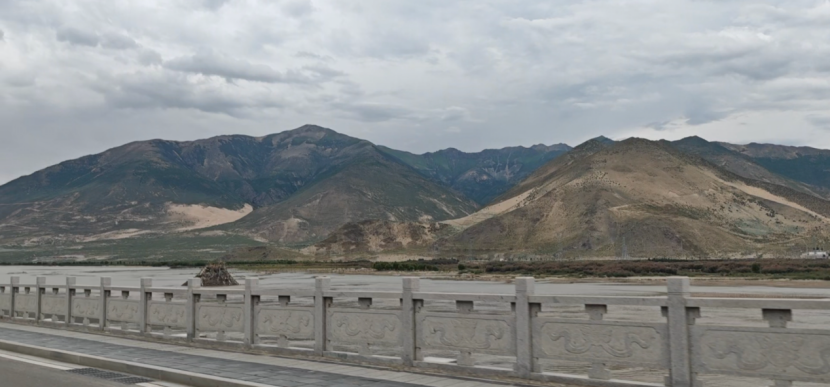
Tranalysis
Shannan is one of the cradles of ancient civilization in Tibet, where there is the first temple in Tibet and the first piece of farmland in Tibet according to legend.
The Yarlung Tsangpo River (referred to as \Yajiang\) flows from west to east through 7 counties (districts) within the territory of Shannan City, with a course of 337 kilometers. On both banks of the Yajiang in Shannan City, there are vast areas of river valley aeolian landforms.

The sand dunes on the north bank of the Yarlung Tsangpo River in Shannan City. The aeolian landforms of the Yarlung Tsangpo River valley are divided into bottom valley dunes and slope valley dunes. The unique geographical location and climatic environment make the Yarlung Tsangpo River basin simultaneously possess ideal conditions for aeolian deposition, such as sand sources, wind power, and accumulation sites. Processes like fluvial action for sand transportation, wind erosion for sand lifting, and the reactivation of ancient dunes for sand supply all provide a rich source of material for the formation of aeolian landforms. See the article \Morphological Evolution and Movement Patterns of Climbing Dunes in the Milin Section of the Yarlung Tsangpo River\ in the June 2024 issue of \Chinese Deserts\. The Paper News reporter Gao Yuting, photo.
On July 19th, reporters from The Paper followed the \60 Years of Brilliance, Charming New Tibet\ concentrated interview activity and observed in Zhanang County, Shannan City, that locals have cultivated tens of thousands of acres of apple orchards in the sandy lands of the Yarlung Zangbo River Valley, with highland apples being sold as far as Nepal. Each person working in the apple orchards of Zhanang County earns an annual income of around 50,000 yuan.
Zhanang County has an apple orchard of 10,200 acres (including the area of roads and other hard facilities) on both sides of the Yarlung Zangbo River. In 2019, Shannan City unified planning and implemented a poverty alleviation project - apple planting in the sandy areas along the Yarlung Zangbo River in Naidong District, Gongga County, Zhanang County, and other places. Firstly, planting apples is a labor-intensive industry, which can drive more local people to increase their income. Secondly, after evaluation, these dwarf apples are suitable for growth in the valley sandy land along the Yarlung Zangbo River in Shannan. In addition to economic benefits, apple trees also have the ecological role of windbreak and sand fixation.

The apple orchard in Langsailing Village, Zaqi Township, on the south bank of the Yarlung Zangbo River in Zhanang County. Photo by Gao Yuting, The Paper journalist.
The head of the Agricultural and Rural Bureau of Zhanang County, Yu Jin, told reporters from The Paper that the sandy lands in the Yarlung Zangbo River Valley are collective village lands. In 2020 and 2021, Zhanang County successively bid for two companies to plant apples on more than 8,300 acres. In 2020, the planting area was 2,000 acres (including the area of roads and other hard facilities), and in 2021, the planting area was 8,200 acres (including the area of roads and other hard facilities), with a total investment of 583 million yuan. All the project investment funds were integrated funds for poverty alleviation in Zhanang County.
After the successful cultivation of apples, this apple orchard of more than 10,000 acres located in the Yarlung Zangbo River Valley area was uniformly handed over to the state-owned enterprise in Zhanang County, Tibet Zhanang County Grain and Oil Company, for unified management and sales.

Zhanang dwarf apple. Photo provided by the interviewee.
Zhanang County Grain and Oil Company's Technical Director Li Shiyin mentioned that in 2023, the 4,000 mu of apples in Langsailing Village, Zhaqi Township, on the north bank of the Yarlung Zangbo River, were sold for a total of 2.76 million yuan, and in 2024, these 4,000 mu of apples were sold for 3.85 million yuan.
The chairman of Zhanang County Grain and Oil Company, Lasang, introduced that in 2024, Zhanang County Grain and Oil Company connected with foreign trade companies and exported 60 tons of apples to Nepal through the Jilong Port in Tibet, with a price of 1000 USD per ton and 1 USD per kilogram. This year, it is expected to harvest about 1400 tons of apples, with orders for export to Nepal amounting to about 500 tons, and the price per ton has slightly increased compared to last year, to 1060 USD. Approximately 30% of the harvested apples are sold locally, 30% are exported, and 40% are sold outside the region.
Additionally, according to media reports, in 2024, the export of dwarf apples from Shannans to Nepal achieved a breakthrough in the foreign trade exports of Shannans City, marking a zero breakthrough.
The apple orchard project in Zhanang County has also driven the increase of local villagers' income. Lasang mentioned that currently, the company has 48 employees. From September to December is the peak period for labor demand, with a workforce of 400 people. Normally, the park employs 126 people, all of whom are villagers from nearby Langsailing Village and other 4 natural villages. Each of the 173 households in the 4 natural villages has someone working in the park, with a daily wage of 190 yuan per person, and those working in the park can earn about 50,000 yuan per person each year. \Those who can come to work every day have an annual income of more than 60,000 yuan.\
In addition to driving local villagers' income growth, the windbreak and sand fixation effects of the apple orchard are also very obvious. Lasang is a local from Zhanang, and he recalls that there used to be a lot of sand in Zhanang County, \walking on the road, not to mention that the mouth is full of sand, the hair is full of sand, now this problem does not exist.\
The city of Shannan has a dwarf apple cultivation area of more than 28,000 mu, with an annual output of about 2,600 tons, driving the annual per capita income increase of people near apple orchards in Naidong District, Zhanang County, and Gongga County by 18,000 yuan.
The Paper has learned that since the 1980s, Zhanang has actively carried out afforestation and windbreak and sand fixation work. After more than 40 years of unremitting efforts, the forest coverage on both sides of the Yarlung Zangbo River and the coverage of grassland vegetation have continued to \double increase\, and the desertification and sandification of land have continued to \double decrease\, with a significant reduction in local sand and dust weather.




